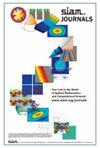交叉熵法贝叶斯更新的认证降维
IF 1.9
3区 工程技术
Q2 MATHEMATICS, INTERDISCIPLINARY APPLICATIONS
引用次数: 3
摘要
在反问题中,模型的参数是根据模型响应的观测值来估计的。贝叶斯方法对于解决这样的问题是强大的;制定参数状态的先验分布,该先验分布用观测值更新以计算后验参数分布。当(例如)前后显著不同和/或参数空间是高维的时,求解后验分布可能是具有挑战性的。我们使用了一系列重要抽样措施,这些措施是通过缓和处理在先验和后验之间存在显著距离的反问题的可能性而产生的。每个重要性采样度量都是通过交叉熵最小化来识别的,如Engel等人在贝叶斯逆问题的背景下提出的。(2021)。为了有效地解决高维参数空间的问题,我们在原始参数空间的低维子空间中建立了最小化过程。其主要思想是分析对数似然函数梯度的二阶矩矩阵的谱,以确定合适的子空间。继Zahm等人(2021)之后,提供了全维和子空间后验之间的Kullback-Leibler散度的上界,该上界可用于确定对应于规定近似误差界的反问题的有效维数。我们提出了在重要性采样序列的每次迭代中最优选择模型和模型梯度评估数量的启发式标准。我们使用工程力学集合在各种参数空间维度上的例子来研究这种方法的性能。本文章由计算机程序翻译,如有差异,请以英文原文为准。
Certified Dimension Reduction for Bayesian Updating with the Cross-Entropy Method
In inverse problems, the parameters of a model are estimated based on observations of the model response. The Bayesian approach is powerful for solving such problems; one formulates a prior distribution for the parameter state that is updated with the observations to compute the posterior parameter distribution. Solving for the posterior distribution can be challenging when, e.g., prior and posterior significantly differ from one another and/or the parameter space is high-dimensional. We use a sequence of importance sampling measures that arise by tempering the likelihood to approach inverse problems exhibiting a significant distance between prior and posterior. Each importance sampling measure is identified by cross-entropy minimization as proposed in the context of Bayesian inverse problems in Engel et al. (2021). To efficiently address problems with high-dimensional parameter spaces we set up the minimization procedure in a low-dimensional subspace of the original parameter space. The principal idea is to analyse the spectrum of the second-moment matrix of the gradient of the log-likelihood function to identify a suitable subspace. Following Zahm et al. (2021), an upper bound on the Kullback-Leibler-divergence between full-dimensional and subspace posterior is provided, which can be utilized to determine the effective dimension of the inverse problem corresponding to a prescribed approximation error bound. We suggest heuristic criteria for optimally selecting the number of model and model gradient evaluations in each iteration of the importance sampling sequence. We investigate the performance of this approach using examples from engineering mechanics set in various parameter space dimensions.
求助全文
通过发布文献求助,成功后即可免费获取论文全文。
去求助
来源期刊

Siam-Asa Journal on Uncertainty Quantification
Mathematics-Statistics and Probability
CiteScore
3.70
自引率
0.00%
发文量
51
期刊介绍:
SIAM/ASA Journal on Uncertainty Quantification (JUQ) publishes research articles presenting significant mathematical, statistical, algorithmic, and application advances in uncertainty quantification, defined as the interface of complex modeling of processes and data, especially characterizations of the uncertainties inherent in the use of such models. The journal also focuses on related fields such as sensitivity analysis, model validation, model calibration, data assimilation, and code verification. The journal also solicits papers describing new ideas that could lead to significant progress in methodology for uncertainty quantification as well as review articles on particular aspects. The journal is dedicated to nurturing synergistic interactions between the mathematical, statistical, computational, and applications communities involved in uncertainty quantification and related areas. JUQ is jointly offered by SIAM and the American Statistical Association.
 求助内容:
求助内容: 应助结果提醒方式:
应助结果提醒方式:


